This was published 7 years ago
Bhutan's Phobjikha Valley: Witnessing sacred wildlife
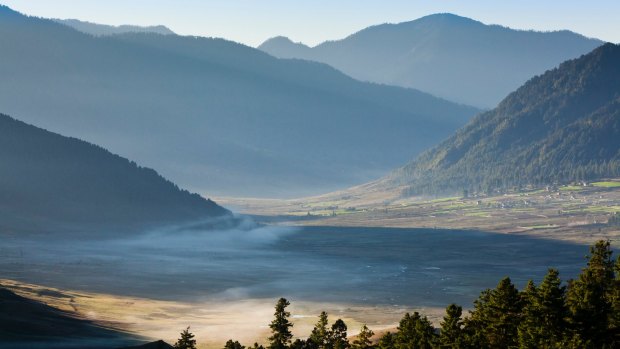
Dawn in Phobjikha, a glacial valley on the western slopes of the Black Mountains. The valley is a designated conservation area.Credit: Katie Garrod
Even monks need a sleep-in. I discover this while sitting, in a not-too-comfy lotus position inside the prayer hall of a Buddhist shedra, or monastic college, in the Gangtey Valley, high in the peaks of mountainous Bhutan, where outside dawn is yet to break. I'm here to observe the 5.15am prayers, except the monks neglected to inform my guide that they have sensibly adopted winter hours.
Early-morning prayers, please note, are now at the marginally more God-forgiving hour of 6am in December and the remainder of winter. But, really, as I wait in the prayer hall, I'm unfazed by the denial of an additional 45 minutes or so of slumber. This is Bhutan, the land of gross national happiness, after all, and I smile through slightly gritted, recently brushed teeth.
It's an honour to be able to witness their pre-dawn ritual, an experience offered by the nearby Gangtey Lodge where I'd just spent the night, with the fee of $US20 for the pleasure, donated to the monastery. Remarkably, the alpine Gangtey Valley is just 135 kilometres from Bhutan's unprepossessing capital, Thimpu, but with the combination of winding, mostly unsealed and rutted, dirt roads and a national speed limit of 40km/h kilometres, it's an arduous, if not torturous, 6½-hour drive here.
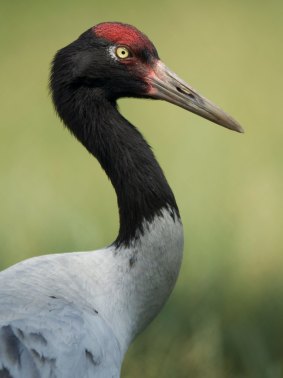
A black-necked crane.Credit: Joel Sartore
In fact, if you were to take a helicopter – there are only two in the whole country – from Paro, site of Bhutan's only international airport another 90 minutes from Thimpu, the travel time would be less than 20 minutes. But, as I'm to discover, the trek to this sublime valley in a nation full of sublime valleys will prove more than worthwhile.
Outside the monastery I can see birds circling against a deceptively white sky, drained in this weak first light of the intense blueness of day that will reveal itself in an hour or two.
I wonder if any of the birds are the famed sacred black-necked cranes – "birds of fortune" as they are known among the locals – that tend to attract visitors like me, more than monks, to this corner of Bhutan. Of course, you don't need to be a twitcher, or a devout monk, to fully appreciate these birds, known here as thrung thrung karm. Each year more than 300 to 500 black-necked cranes on average fly at high altitude over the Himalayas in Tibet, their summer breeding grounds, wintering in the milder Phobjikha Valley, of which Gangtey is part.
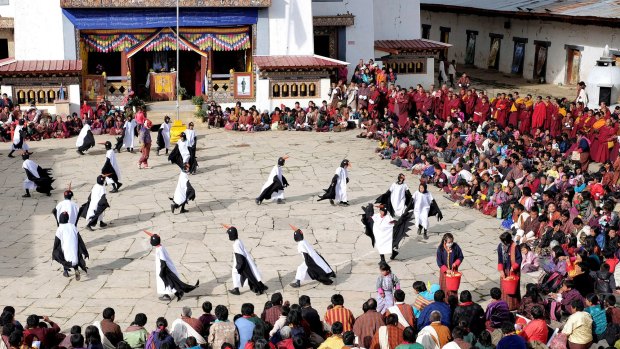
Children from Bayta Primary School perform the black-necked crane dance in the Phobjikha Valley, Bhutan.Credit: Getty Images
The 5000 inhabitants of the Phobjikha Valley, monks included, revere the cranes – the last to be discovered of the world's 15 species – to such a degree that the government chose to bury cabling for the electricity, which was only connected a few years ago, underground rather than have cables on poles, to protect the birds. It was an extravagant measure for what is a still poor and developing nation but one that underscores the importance of the cranes to Bhutanese society.
They believe that the first birds, which tend to arrive in late October each year, thrice circle Gangteng Gompa, the main and magnificent 17th-century monastery below which lie the wetlands where the cranes live in winter. The act, deeply embedded in folklore, is perceived as a kind of blessing by these "auspicious harbingers of hope and prosperity" at the end of the harvest season in the valleys.
Back at the monastery a gong is being beaten firmly enough to scare off any birdlife, or any other life form for that matter, with the clamour drowning out the distant howls of stray dogs, the soundtrack of the Bhutanese night, let alone rouse the red-robes monks. They eventually drift in, rubbing their eyes and their hands to warm up, yawning then prostrating themselves before Buddha in the middle of the hall.
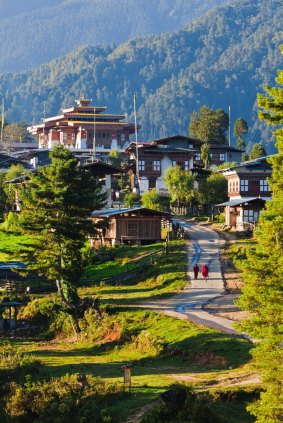
Morning light on the village of Gangtey, at the head of the Phobjikha Valley.Credit: Katie Garrod
Finally, they take their place and soon the room is filled with chanting monks. One monk, whom my guide informs me is the "discipline counsellor", performs circuits. He has a note book and pen and is checking for shirkers.
Prayers over, breakfast beckons in the truly cold light of day. By the time I arrive back at my accommodation, Gangtey Lodge, consisting of 12 spacious rooms each with fireplaces and standalone bathtubs positioned to deliver perfect valley vistas, sunlight is pouring into the main lounge.
From the lodge, which is designed to blend in with the traditional stone and timber black and white farmhouses that dot the valley, it's an easy stroll straight up (and down) the village's undulating main street, dominated by a large stupa, to Gangteng Gompa. Inside the monastery's gates we pass a young monk scooping up yak dung with sheets torn from a cardboard box (a victim of a discipline counsellor, perhaps?)
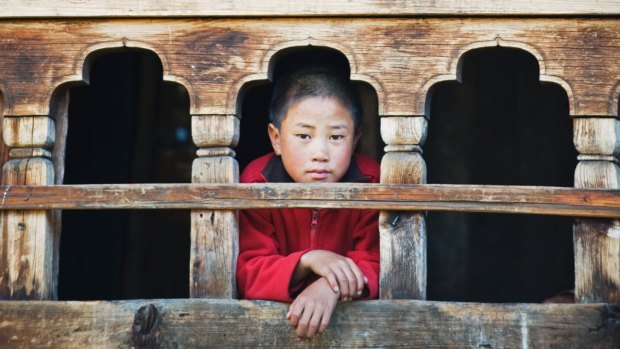
A monk at the window of the Gangtey Gompa Monastery.Credit: Christian Kober
When we enter the vast courtyard of the towering monastery we discover it is occupied by novitiate monks sitting an exam. Some shelter beneath their draped crimson robes to protect themselves from the surprisingly intense early winter sun.
But our main mission this morning is to glimpse the black-necked cranes below her. We take the gorgeous nature trail from near here that cascades deep into the valley and is close to the wetland habitat of the black-necked cranes. Descending 100 metres or so, we traverse pine forests and pass by the meandering Chhu Nap, or Black River, flanked by stupa-studded fields crowned by multistorey farmhouses.
Our destination is one of Phobjikha's main attractions, the Black-Necked Crane Visitors' Centre on the opposite side of the valley. Soon, through breaks in the forest, we glimpse the first thrilling, unmistakable sight of the birds, framed on the treeless, swampy valley floor, by greying prayer flags fluttering in a gentle breeze.
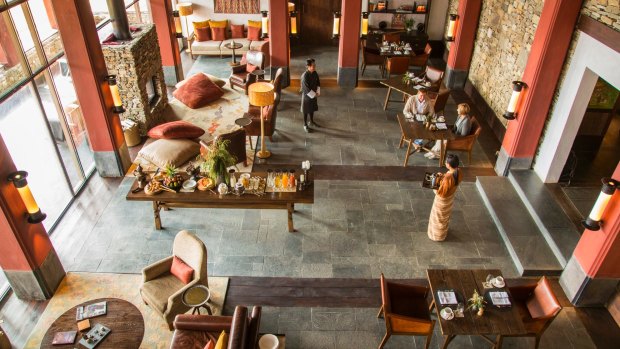
The luxurious Gangtey Lodge.Credit: Getty Images
After a few hours of walking and observing, we cross the valley and finally reach the centre where we meet "Karma", an injured crane believed to have been attacked by dogs. The bird is being cared for by the small staff in a makeshift enclosure at this modest facility. Up close, the bird is taller than I had imagined – about 140 centimetres, with a fetching fleck of red plumage on its crown.
The centre, where you can view the birds through telescopes, at the time of my visit late last year, had raised $US7000 out of the $US20,000 needed to build a rehabilitation centre for injured cranes. Despite the occasional misadventure, the cranes seem to love their adopted annual home in Bhutan. Since last year more than 600 birds arrived to winter in this valley, the highest number for nearly three decades, according to the kingdom's Royal Society for the Protection of Nature.
The black-necked cranes have a few months left in the valley before they return to Tibet but for me, after a brief visit, it's time to fly the coop and continue my journey around the rest of Bhutan. Just like the cranes, I'd love to return to Phobjikha one day though next time I may skip those early morning prayers. That bit is strictly for the birds.
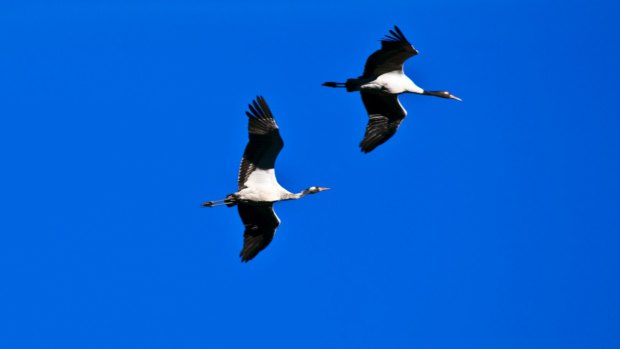
Each year the black-necked cranes fly over the Himalayas in Tibet, their summer breeding grounds, to winter in the milder Phobjikha Valley. Credit: Jason Edwards
FIVE MORE THINGS TO DO IN THE PHOBJIKHA VALLEY
ONE FOR THE BIRDS The annual Black-Necked Crane Festival is held every year in the Phobjikha Valley on November 11. Begun in 1998, the festival features cultural and mask dances, short plays about the cranes and their environments in the valley as well as exhibitions.
IMMERSE YOURSELF At Gangtey Lodge you can experience a traditional Bhutanese stone bath inside the new stone bathhouse and spa. The temperature of the water is so scorchingly hot it's reminiscent of a Japan onsen.
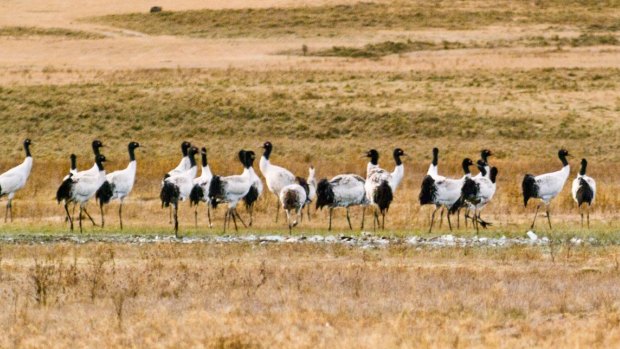
Black-necked cranes in Phobjika Valley.Credit: Jason Edwards
TARGET PRACTICE The national sport of Bhutan is archery, or dha, and tournaments are as regular a sight in the country as cricket matches are in India. Gangtey Lodge has bows and arrows for visitors who would like to learn archery from staff members.
A HAVEN FOR HIKERS The Phobjikha Valley is perfectly suited for exploration on two feet, whether it be easy walks or two to three day hikes. These include the Gangtey Trek from Phobjikha to Teke Zampa best undertaken between the cooler months of October to May.
SADDLE UP It's possible to explore parts of the valley not just by horseback but also by bicycle. Many bike trails are relatively flat and pass through lush forests and grassy hillsides though there are plenty of steep slopes for the more serious mountain bikers.
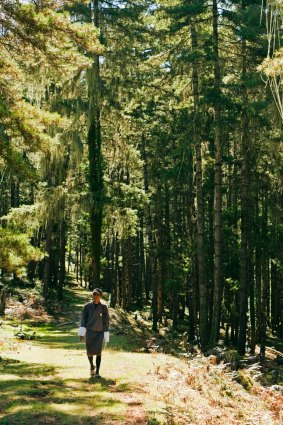
A Bhutanese man walks in the forest in Phobjika Valley. Credit: Katie Garrod
TRIP NOTES
MORE INFORMATION
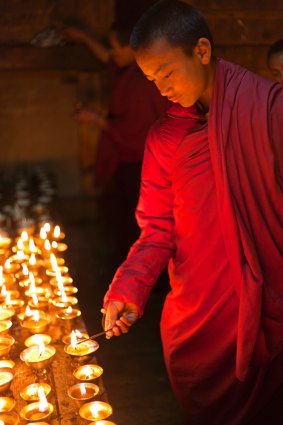
A young monk lighting butter lamps at Gangtey Gompa. Credit: Katie Garrod
VISIT
To control the impact of tourism on Bhutan, there are several conditions imposed on visitors. The $US200 a day (low season) and $US250 a day (high season) package includes a minimum of three-star accommodation, food costs, an experienced guide and transportation (with driver) within the country. The price also includes a $65 a day royalty that goes towards free education, free healthcare and poverty alleviation in Bhutan. All of these services will be arranged by a travel agency at the time of booking.
FLY
Druk Air – Royal Bhutan Airlines is the monopoly international carrier to and from Bhutan. It operates regular daily services in and out of Paro, the only international airport. The best departure points for Australians to Bhutan are Bangkok and Singapore. See drukair.com.bt
STAY
The outstanding and luxurious Gangtey Lodge (easternsafaris.com) is close to the village of Gangtey Gompa and the nature trail. Doubles from $US425. Guests can also attend evening prayer service at the shedra at 6.30pm. If you wish to learn more about the black-necked cranes, the lodge can invite the centre staff to provide further information over evening drinks in the main lounge. Other recommended luxury lodges and hotels in Bhutan are Zhiwa Ling Hotel (zhiwalin.com), Paro, Taj Tashi Thimpu (tajhotels.com); Amankora, Punakha (aman.com) and Como Uma Paro (comohotels.com)
Anthony Dennis was a guest of the Tourism Council of Bhutan, the Unique Tourism Collection and Druk Air.
Sign up for the Traveller Deals newsletter
Get exclusive travel deals delivered straight to your inbox. Sign up now.